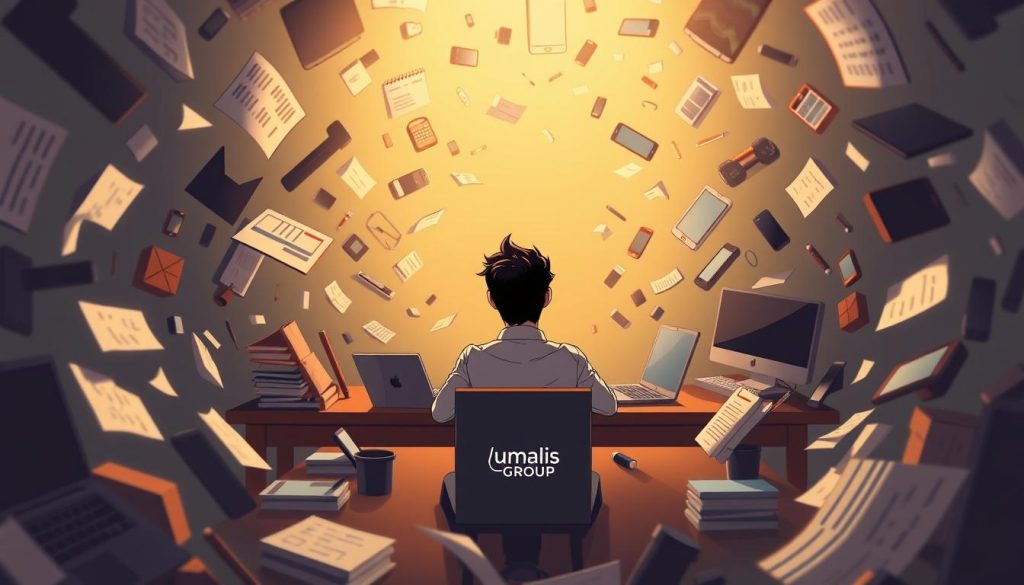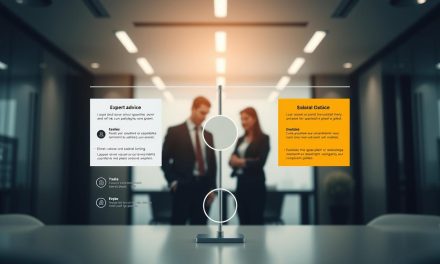60% of professionals report they produce their best results in a quiet, solo setting. That surprising figure shows how crucial focused time has become for high-stakes tasks.
We define what it means to favor a solo environment—putting earbuds in, arriving early or staying late to secure uninterrupted blocks. This style supports deep focus and clearer outputs when schedules are hybrid and asynchronous today.
Why it matters: structured strategies help you protect time, boost decision confidence, and turn focused effort into measurable delivery. You will learn practical steps to reduce bottlenecks, set respectful boundaries, and keep collaboration effective without losing breathing room.
Start with small wins: tight time boxes, simple interruption rules, and a few environment tweaks. These quick changes create sustainable gains and show visible value to teams and clients.
Table of Contents
Key Takeaways
- Quiet, solo blocks drive higher productivity for complex tasks.
- Clear strategies protect focus while keeping you aligned with teams.
- Small changes this week can deliver visible, measurable value.
- Boundaries signal availability and preserve execution time.
- Hybrid models increase the importance of structured solo time.
What Work Independence Means Today
Many people now design their calendars around uninterrupted blocks to handle complex tasks. This preference favors focused, solo hours and clear signals to colleagues.
Definitions matter: we treat independent work as the practical setup of a quiet space and schedule. Working independently is the act of executing a deliverable alone. The broader mindset of work independence guides when and why you choose those modes.
The solo environment supports deep-focus days. Use time-blocking, earbuds, and meeting-free days to cut context switching when people around you create interruptions.
| Aspect | Modern method | Practical signal |
|---|---|---|
| Deep focus | Time-blocking 2–4 hour slots | Calendar status: \ »Focus\ » |
| Solo setup | Quiet desk or private room | Earbuds or \ »do not disturb\ » sign |
| Ethos | Designated deep-focus days | Team norms and booking rules |
Historical examples show the value of solitude. Thoreau, Earhart, and Newton all used distance and control of inputs to produce breakthrough results. You can adopt those lessons ethically by balancing freedom and team responsibilities, and by choosing simple methods to protect your focus.
The Benefits and Importance of Working Independently
Focused solo periods deliver measurable gains in throughput and clarity. These benefits show up as fewer errors, clearer milestones, and higher overall productivity for many professionals.
Focus and meaningful progress: Quiet blocks support deep concentration. Individuals with private spaces complete complex analyses faster and with less rework. Interruptions are costly; short refocus cues—micro-breaks or a two-minute reset—help regain momentum.
Flexibility and creativity: Freedom over sequencing lets you choose pacing that fits the task. This reduces repetitive edits and often unlocks novel approaches that routine collaboration can miss.
Work-life balance: Batch heavy cognitive tasks early, routine items later, and align energy with life demands. That pattern protects reserves and reduces burnout while improving delivery consistency.
Career growth and visibility
Consistent delivery makes your talents visible. Share brief status notes and concise documentation to keep stakeholders informed without constant check-ins. These lightweight norms translate focused effort into clear professional growth.
For guidance on balancing solo flow with team norms, see balancing solo and team norms.
Independent Work Strategies That Boost Productivity
A few disciplined methods can transform scattered days into predictable delivery. We outline practical approaches you can apply this week to protect focus and move projects forward.
Time management methods: Pomodoro and calibrated cycles
Pomodoro uses 25/5 cycles to keep concentration high and fatigue low. Try three cycles for deep analysis, then a longer break.
Time blocking to shield deep focus
Block specific calendar slots for priority projects. Group similar tasks to reduce context switching and preserve cognitive energy.
Goals, priorities and self-imposed deadlines
Set SMART goals and run the Eisenhower Matrix to sort urgent from important. Add self-imposed deadlines to create healthy urgency and prevent stalling.
- Use 25-minute sprints for complex tasks, adjust length as needed.
- Reserve morning blocks for high-impact projects and email later.
- Share short status notes with peers to keep visibility without interrupting focus — see our guide on balancing solo and team norms.
« Small, repeatable rhythms beat sporadic bursts. Track cycles, celebrate wins, and tune routines regularly. »
| Technique | Benefit | How to measure |
|---|---|---|
| Pomodoro cycles | Improves sustained attention | Cycle counts & time on task |
| Time blocking | Fewer interruptions, higher output | Planned vs. actual blocked hours |
| SMART goals + Eisenhower | Clear priorities, less rework | Milestones met & task completion rate |
| Routines & accountability | Sustained motivation and momentum | Peer check-ins & small-win log |
Start simple: adopt one method, measure a leading indicator, and refine. Short wins compound into steady project progress and lasting productivity.
Designing a Focused Workspace for Fewer Distractions
A clear, intentional workspace reduces friction and helps you focus faster each day. Start by zoning a dedicated area for planning, execution, and review so tools and references are ready when you need them.

Organize your space and personalize your environment
Declutter weekly to avoid slowdowns from lost materials. Keep a simple layout: planning on the left, execution center, review items on the right.
Personal touches—warm lighting, ergonomic seating, and a visual cue—can improve attention and reduce fatigue during long sessions.
Minimize digital noise with website blockers and notification control
Use website blockers and device focus modes during deep blocks. Batch notifications and set clear status messages to signal availability to colleagues.
Remote options and a home office that supports focus
Try remote work one day per week to gain physical distance for strategy, analysis, or writing. When remote, keep a private workspace, reliable connectivity, and a clean background.
| Action | Benefit | Quick metric |
|---|---|---|
| Zone your desk | Faster transitions | Minutes to start task |
| Weekly declutter | Fewer lost items | Less searching time |
| Blockers & focus mode | Fewer digital distractions | Distraction count per day |
| Status signals | Protected focus hours | Interrupted sessions avoided |
« Small, repeatable setup changes help you get into flow and sustain higher-quality output. »
Building Autonomy in Team and Workplace Settings
A few shared signals and short windows can transform how a team balances heads-down effort and contact.
Set interruption systems and norms with your team. Co-design a simple protocol: earbuds or a green/red desk card as a visible signal, defined office hours for questions, and clear response SLAs for urgent items.
These rules protect focus and keep collaboration flowing. When others follow the same signals, meetings shrink and decision cycles speed up.
Balance visibility with solo time: casual chats and context
Schedule brief, regular check-ins and casual chats to share context and build rapport with people you depend on.
Short conversations prevent long threads later. They preserve visibility without creating meeting overload.
Adopt a growth mindset and pursue continuous learning
Growth comes from effort and feedback. Encourage courses, peer reviews, and stretch assignments so skills expand and autonomy rests on competence.
« Talent grows when we treat challenges as learning opportunities. »
Own your outcomes: responsibility, decisions, and new tasks
Own deliverables. Make timely decisions within your remit, escalate with options, and volunteer for new duties when you have capacity.
Keep others informed with concise updates, weekly plans, and short risk notes so management sees momentum without constant check-ins.
- Co-design an interruption system: signals, office hours, SLAs.
- Reserve short casual chats to boost context and team rapport.
- Invest in learning and apply feedback to show measurable growth.
- Make decisions, escalate with options, and claim new tasks proactively.
Managers benefit by trusting teams with clear goals and light rituals. For practical support on strengthening initiative and autonomy, see our dedicated guidance reinforce initiative and autonomy.
Overcoming Challenges of Working Independently
When tasks pile up and time feels scarce, a clear plan turns hesitation into progress. Below we outline practical strategies you can apply now to beat procrastination and recover focus after interruptions.
Beating procrastination: break down and remove temptations
Chunk large tasks into small, atomic steps with tight time boxes. Clear, short deadlines make each task feel achievable.
Pre-commit to blocker apps, put your phone out of reach, and clear your desk to remove common temptations. Pair routines with accountability nudges to stay motivated and celebrate small wins.

Adaptability under interruptions: refocus tactics and mental resets
Interruptions happen. Use a two-minute reset—breathing, a quick note, and a priority recheck—to regain momentum. Establish a top-of-hour ritual so individuals can re-enter flow quickly after messages or meetings.
- Use « if-then » plans for predictable derailers.
- Keep hydration, stretch, and a brief environment refresh as personal cues.
- Track time on task and small milestones to maintain motivation.
| Tactic | Benefit | Quick metric |
|---|---|---|
| Task chunking | Faster starts | Tasks completed/day |
| Two-minute reset | Faster refocus | Minutes to resume |
| Accountability nudges | Higher motivation | Weekly checkpoints |
« Small, repeatable strategies keep projects moving even when days get noisy. »
Conclusion
Choose a single small habit today that protects your best thinking and you’ll see results this week.
Independent work becomes a reliable operating system when you protect space, align goals, and codify simple practices that raise productivity and clarity.
You’ll build the ability to choose decisions, define goals, and sequence projects so critical work gets done on the right day. Master a few core routines—time blocks, quick resets, and clear status signals—to improve your ability work independently fast.
Keep collaboration respectful: preserve team ties while honoring focused hours. Small environment upgrades at home or office help get traction quickly and make work done visible to others.
Commit to one change today: schedule a remote work session, refine two goals, or declutter your space—and repeat until it sticks.
FAQ
What does "work independence" mean today and how is it different from independent work?
Today, it refers to the ability to manage tasks, time, and decisions with autonomy while remaining accountable to outcomes. Independent work often describes a contractual or freelance status. Working independently emphasizes daily habits and environments that let you deliver results without constant supervision.
How can I create solo-focus days to maximize deep concentration?
Designate specific blocks in your calendar for uninterrupted effort, signal availability to colleagues, and use tactics such as Pomodoro intervals and time blocking. Prepare your space, disable nonessential notifications, and start with a clear, prioritized task list to protect momentum.
Who are some historical icons of independent professional achievement and why mention them?
Figures like Henry David Thoreau, Amelia Earhart, and Isaac Newton illustrate different facets of solitary dedication: reflective practice, bold initiative, and intense focused study. Their stories offer inspiration for disciplined routines and a growth mindset.
What concrete benefits come from doing focused, uninterrupted task work?
You gain meaningful progress on complex tasks, reduced context switching, faster delivery, and improved quality. Focused periods also increase creativity and reduce stress by making goals tangible and manageable.
How does autonomy improve creativity and flexibility in professional output?
Autonomy lets you experiment with methods, schedule work around peak energy, and pivot quickly on ideas. That freedom encourages novel solutions because you choose approaches aligned with your strengths and constraints.
Can independent approaches help maintain a healthier work-life balance?
Yes. When you control time allocation and set clear boundaries, you can align work with personal priorities, safeguard rest, and allocate energy deliberately—leading to steadier productivity and lower burnout risk.
What strategies boost productivity when working alone?
Combine Pomodoro to sustain attention, time blocking to protect deep work, SMART goal setting and the Eisenhower Matrix for priorities, plus self-imposed deadlines to create urgency. Regular routines and accountability partners help sustain progress.
How do self-imposed deadlines increase momentum without external pressure?
They create predictable milestones and psychological commitment. By breaking projects into short, measurable targets you produce regular wins and reduce the scope for delay, which improves motivation and clarity.
What should a focused workspace include to reduce distractions?
Keep the area organized and tailored to your tasks, use ergonomic furniture, control lighting, and limit visual clutter. Add practical tools like noise-cancelling headphones and place frequently used items within reach.
How can I minimize digital noise effectively?
Use website blockers, schedule email and messaging checks, silence push notifications, and create separate browser profiles for focused work. Clear, written availability guidelines help others respect your concentrated hours.
What are best practices for setting up a remote or home office that supports autonomy?
Choose a dedicated location, separate work and leisure zones, invest in reliable connectivity and a good chair, and establish start/end rituals. Communicate your hours and expectations clearly to household members and colleagues.
How do I build autonomy within a team without losing collaboration?
Agree on interruption norms, use async updates, and set shared visibility tools like project boards. Balance solo focus with scheduled touchpoints to preserve alignment and trust while protecting individual deep work time.
What interruption systems help teams respect focused work periods?
Implement status indicators (calendar blocks, Slack statuses), agreed « do not disturb » windows, and an escalation protocol for urgent issues. These norms reduce unplanned disruptions and streamline decision flow.
How can I develop a growth mindset while working independently?
Seek regular learning opportunities, request constructive feedback, track progress metrics, and take on stretch assignments. Treat setbacks as experiments that inform better methods and skill development.
What practical steps help overcome procrastination when tackling big tasks?
Break projects into small, actionable steps, set a short kickoff commitment (e.g., 10 minutes), eliminate immediate distractions, and reward completion of micro-tasks to build forward motion.
How do I adapt quickly after interruptions and regain concentration?
Use a short mental reset: step away for a minute, perform a breathing exercise, then review a concise checklist of next actions. Re-establish context by scanning your last saved note or using a time-boxed restart routine.
How do I demonstrate my talents and leadership while working autonomously?
Deliver visible outcomes, share concise progress reports, volunteer for key responsibilities, and document lessons learned. Clear communication and consistent delivery build credibility and open paths for advancement.





